 Research Article
Research Article
Effect of Culm Age and Height on the Chemical Properties tf The Culm in Different Bamboo Species
Yalew Dessalegn1*, Balkeshwar Singh2 and Aart W van Vuure3
1Research Scholar, Department of Mechanical Design & Manufacturing Engineering, Adama Science & Technology University, Adama City, Ethiopia
2Professor, Department of Mechanical Design & Manufacturing Engineering, Adama Science & Technology University, Adama City, Ethiopia
3KU Leuven, dept. Materials Engineering; Campus Groep T, Composite Materials Group, Andreas Vesaliusstraat 13, 3000 Leuven, Belgium
Yalew Dessalegn, Research Scholar, Department of Mechanical Design & Manufacturing Engineering, Adama Science & Technology University, Adama City, Ethiopia.
Received Date: July 15, 2022; Published Date: August 17, 2022
Abstract
This research aims to investigate the chemical properties of bamboo species in Ethiopia on the influence of age and height of the culm. The chemical properties of bamboo species in Ethiopia were not investigated so far from the other research work using the current research factors. The percentage of cellulose content is higher value recorded compared to hemicelluloses content. The percentage of lignin content of Injibara and Mekaneselam is higher compared to hemicelluloses content. However, the percentage of hemicelluloses of Kombolcha bamboo fibres is higher compared to lignin content.
As a result of this research, we observed small but significant increases in cellulose and lignin content from the bottom to top along the culm at all age. Bamboo species fibres increased cellulose content when the culm age older. The hemicellulose content of Injibara, and Kombolcha bamboo fibres is a slight increase along the culm height toward top position, whereas Mekaneselam bamboo fibre slightly decreased from the bottom to top position.
Cellulose content of Injibara, Kombolch, and Mekaneselam bamboo fibres is 49.12–50.17%, 43.25–49.02%, and 53.06–53.93%, hemicelluloses content is 19.12–21.78%, 19.31–23.89%, and 16.51–19.06% at the ages of 1–3 years old, respectively. Furthermore, lignin content is 19.16–22.48% and 19.29–22.59% at the ages of 1–3 years old, respectively.
This result demonstrated that bamboo species in Ethiopia can be a source of feedstock for lignocelluloses ethanol and bamboo fibres composite production since it has higher cellulose content.
Keywords:Age; Bamboo species; Cellulose; Hemicelluloses; Lignin; Culm height
Introduction
In Ethiopia, there is a scarcity of bamboo supervision and utilization research. One of the most significant opportunities is the proper utilization and expansion of bamboo [1]. Challenges such as a shortage of trained manpower, training, and technology, capital, working and selling the place, market linkage, support service, institutional, attitudinal, and bamboo resource-related challenges have hampered the development of Ethiopian bamboo sources [2]. The examination of bamboo culm properties at various ages and diameter groups aids in the selection of clump or culm, which improves the commercial utilization of a specific species [3]. Properties of bamboo in terms of its anatomical, physical, mechanical, and chemical properties aids in determining maturity age, which improves processing and utilization [4]. Bamboo culm typically matures in two to three years, reaching its peak strength [5,6]. Bamboo properties, on the other hand, vary depending on species, age, location, and external factors [4,7]. According to Correal and Arbelaez [8], the age of bamboo is an important factor that influences its mechanical properties.
Changes in chemical composition with age are less well understood. It was previously assumed that lignification was completed during the first growing season [9,10]. Liu et al., [11] on the other hand, it demonstrated that lignification continues after the first year of growth, particularly in the parenchyma cell walls. Fibre and parenchyma cell walls thicken during stem growth to form a polylamellate structure, and lignification’s process of these cells can last up to seven years. Pubescens et al., [9] discovered that fibers continued to thicken their walls well into the second year.
Marinho et al., [12] investigated the chemical compositions of one, two, and three-year-old Gigantochloa scortechinii and discovered that the contents of holocellulose, a-cellulose, and lignin increased slightly from one to three years of age. Zhu et al., [13] found that The lignin content of the epidermal cell wall did not improve after one month, but it actually increases in fibres and ground parenchyma cells during the first year but not afterwards..
Bamboo’s chemical composition and utilization are linked, as it contains 50-70 percent holocellulose, 30 percent pentosans, and 20-25 percent lignin. There are some differences between species in these main constituents, but any influence on technological properties is unknown [14]. Cellulose and hemicelluloses are carbohydrate polymers that are composed of simple sugar monomers, whereas lignin is a polymer composed of phenylpropane units [15]. A long-chain polymer of glucose that is structurally distinct from starch is known as cellulose.
The fibrous nature of wood cells is caused by the cellulose component’s linear, oriented, crystalline arrangement. Hemicelluloses are “branched polymers of five-carbon sugars (pentoses) used to make the matrix in which cellulose fibrils are embedded.” Although the cellulose structure is the same in all species, the hemicelluloses differ significantly, particularly between hardwoods and softwoods.
Lignin, the third constituent of the cell wall, is a threedimensional polymer made up of phenylpropane units that have randomly grown into a complex large molecule with a variety of linkages between the building blocks.
Lignin functions as both a stiffening agent within the fibers and a cement between the wood fibers. In the production of chemical wood pulps, it is dissolved by various chemical processes, leaving the cellulose and hemicelluloses in fibrous form. Some hemicelluloses are lost during the process due to their lower molecular weight, higher solubility, and ease of hydrolysis [16]. Bamboo’s chemical composition appears to change with age. It is unknown whether chemical composition varies with height position within a given culm. Any of these variations are likely to be related to changes in physical and mechanical properties.
Accordingly, the purpose of this investigation was to evaluate the influences of age, height and bamboo species in Ethiopia on the chemical composition that had not been studied by the previous researcher so far.
The chemical composition of bamboo species in Ethiopia such as Injibara, Kombolcha, and Mekaneselam would be studied to evaluate the percentage contents of cellulose, hemicelluloses, extractives, lignin, and ash contents between them. Comprehensive understanding of the chemical components of bamboo species will facilitate their use in the industrial forestry sector and aid in their utilization in the chemical and biochemical industries.
Materials and Methods
Study area
The geographic location and climatic conditions of the testing sites are described in Table 1. Injibara region is the high altitude in the sea level next to the Mekaneselam region, but Kombolcha is low altitude and high maximum temperature [17-19].
Table 1:Geographic location and climatic conditions of the testing sites.

Sampling technique
The bamboo culm was harvested in November 2020 G.C at Kombolcha, and Mekaneselam town in South Woll Zone, as well as, Injibara in West Gojam zone of Amhara Region, Ethiopia. Three representatives of bamboo culms were harvested in each age of one, two, and three years old. The age of bamboo culm was known by experienced field personnel using its color and sheath in the culm. The culm was later subdivided into three parts such as the bottom, middle, and top portions based on the criteria of internodes length, and outer diameter.
Determination method of culm age
As presented in Table 2, internodes color and sheaths are used to determine the ages of bamboo species in Ethiopia. At an early age, white flour with culm sheaths has covered the whole of the culm, whereas at a young age, light green with some culm sheaths are covered in the culm, and older age, dark and darker green without culm sheaths are covered in the culm.
Table 2:Age determination of bamboo species in Ethiopia.

Determination methods of culm height
As presented in Table 3, criteria set for the division of the Bamboo culm along the height used bottom criteria in the culm wall thickness and top criteria in the outer diameter. The middle position is between the bottom and top positions. 1, 2 and 3 years– old of bottom criteria in the wall thickness are greater than 9.25 mm, 8.35 mm, and 7.15 mm, moreover, top criteria in the outer diameter are less than 104 mm, 74 mm, and 62 mm respectively.
Table 3:Criteria setting for the division of bamboo culm along with the height.

Measuring chemical composition
Chemical constituents of the culms have influenced on the application area like structural, construction, biofuel and fibers board production. The main chemical constituents of bamboo culms are Cellulose, hemicelluloses, lignin and extractives.
Strips of the culm are cut into small pieces using scissors, then grind using higher duty coffee grinder mill in powder form. The powder is sieved in the sieve size of 425 and 375 μm. The sample size of the particles is passed through in sieve size of 425 μm and lay down on sieve size of 375 μm. The current studies have applied the methods of gravimetric methods to evaluate the chemical compositions of the culm. The gravimetric methods are selected for chemical constituent analysis in considering economically suitable for developing countries because of cheap and mostly available on the shelf [20].
As shown in Figure 1, the chemical composition of bamboo species in Ethiopia are measured using gravimetric weight methods. Various types of chemical and equipment’s are used for measuring the chemical constituent of bamboo species in Ethiopia [21].
Figure 1:Determination methods of chemical composition of bamboo species in Ethiopia.
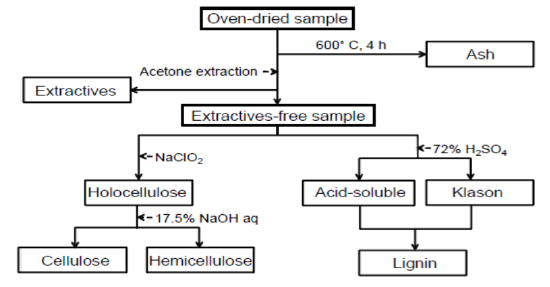
Measuring holocellulose content
As indicated in Figure 2, 2 g (O. D) extractive-free bamboo powder samples were put in 250 ml flasks with small watch glass covers. Following that, 80 mL of distilled water, 0.5 mL of cold glacial acetic acid, and 1 gram of NaClO2 were applied to the samples. The flasks were then placed in a water bath kept at 70°-80°C. Every hour for three hours, 0.5 ml of cold glacial acetic acid and 1 g of NaClO2 were added to the flasks, and the contents were constantly mixed thoroughly. The flasks were cooled for three hours until the temperature reached 25 °C. Before recycling, the flask mixture was then filtered into known-weight G-2 glass crucibles. The residues were thoroughly rinsed [21,22]. The Holocellulose content of bamboo species in Ethiopia was calculated using following formula:
Figure 2:Determination methods of chemical composition of bamboo species in Ethiopia.

Holocellulose % =
W2 - Stands for weight of crucible + sample.
W1 - Stands for weight of empty crucible.
Measuring cellulose contents
As indicated in Figure 3, 2 g of oven-dried holocellulose samples were put in 250 ml beakers with small watch glass covers. The samples were then thoroughly mixed for 5 minutes after being treated with 10 ml of 17.5% NaOH. 15 ml of 17.5 percent sodium hydroxide solution was added to the reaction mixture in three equal portions (3-5 ml) at 5-minute intervals with constant stirring. After 30 minutes of allowing the specimens to react with the solution, 33 ml of distilled water was added to each flask and left for another hour. Vacuum suction was used to filter the contents of the beakers into G-2 glass crucibles of known weight. The residues from each flask were washed with 100 ml of 8.3% NaOH first, then with water [21,22]. The cellulose content of bamboo species in Ethiopia was calculated using following formula:
Figure 3:Measuring cellulose content.
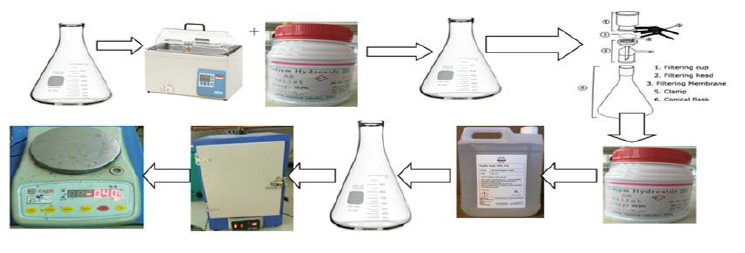
Cellulose % (On the basis of Holocellulose=100)
W2=Weight of the oven-dry cellulose residue
W1=Weight of the original oven-dry holocellulose sample.
Measuring lignin content
As indicated in Figure 4, in 100 ml beakers, 1g oven-dried extractive-free dusts were put. In each beaker, 15 mL of cold sulfuric acid (72%) was slowly added while stirring and thoroughly mixed. The reaction was stirred frequently for two hours. After two hours, the specimens were transferred by washing them with 560 ml of distilled water into 2,000ml flasks, diluting the sulfuric acid concentration to 3%. For four hours, the flasks were placed on hot plates. The beakers are removed from hot plate ,then the contents of the beakers were allowed to settle. The contents of the flasks were filtered into known weight G-3 glass crucibles and washed with distilled water. The residues were oven-dried at 105±2 °C [21,22]. The lignin content of bamboo species in Ethiopia was calculated using following formula:
Figure 4:Determination of lignin content.
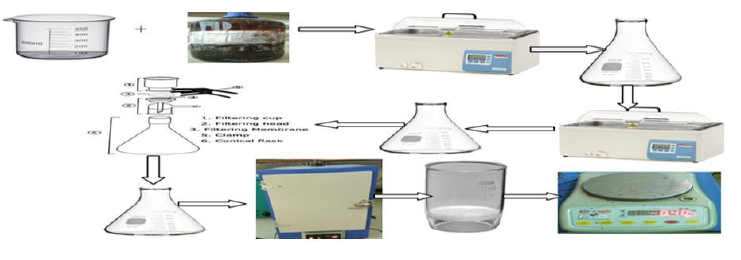
Lignin % =
W2- Stands for weight of crucible + sample.
W1- Stands for weight of empty crucible.
Measuring extractive contents
As indicated in Figure 5, 60ml of acetone with 1gm (O.D) samples of bamboo powder are mixed and inserted in water bath at 100 °c for 2 hrs. The mixed solution is washed with distilled water and dried in the oven at 105 ±2 °C until constant weight was obtained.
The crucibles were then cooled in a desiccator and weighed
until they reached a constant weight [21,22]. The extractive content
of bamboo species in Ethiopia was calculated using following
formula:
Extractives content % =
W2 - Stands for O.D. weight of sample.
W1 - Stands for weight of crucible with sample-Weight of empty
crucible
Figure 5:Determination of extractives contents.

Measuring ash contents
2 g (O.D) samples of bamboo powder were placed in the
crucible. Crucibles with contents were placed in the muffle furnace
and ignite for 2 hours. The temperature of final ignition was 600 °C.
Removed the crucibles with its contents to a desiccator, replaced
the cover loosely, cooled and weighed accurately [21,22]. The
ash content of bamboo species in Ethiopia was calculated using
following formula:
Ash % =
W2 - Stands for weight of crucible + sample.
W1- Stands for weight of empty crucible
Results and Discussions
Measuring cellulose contents
The influence of age and height on the cellulose content is drawn in Figure 6. The mean cellulose content of Injibara, Kombolcha, and Mekaneselam bamboo fibres is highest at the age of 2 (52%), 2 (49%), and 2 (54%), and lowest at the age of 1 (49%), 3 (43%), and 3 (53%), whereas they are highest at the middle (51%), top (46%), and middle (54%), and lowest at the bottom (48%), bottom (45%), and bottom (52%), respectively.
Figure 6:The effect of age and height on the cellulose content of bamboo fibres in Ethiopia.
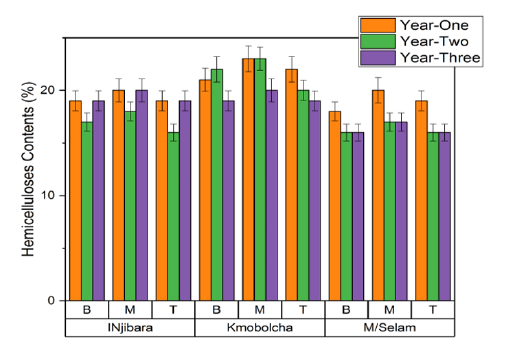
The cellulose content of the middle parts of Injibara bamboo is 6% higher compared to the bottom, whereas 2 years old is 5% higher compared to 1 year old. The top parts of Kombelcha bamboo is 2% higher cellulose content compared to the bottom, whereas 2 years old is 11% higher compared to 3 years old.
The middle parts of cellulose content of Mekaneselam bamboo is 3% higher than the bottom part, whereas 2 years old is 2% higher compared to 3 years old.
The highest and lowest percentage of cellulose content are found in Mekaneselam and Kombolcha bamboo fibres, respectively.
Mekaneselam bamboo fibres have 9%, and 4% higher cellulos content compared to Kombolcha, and Injibara, respectively, whereas Injibara bamboo fibres are 5% higher cellulose content compared to Kombolcha bamboo fibres.
Y. alpina and Dendrocalamopsis oldhami are 46.76 and 45.0% which higher cellulose contents than the current results of 1 and 2 years-old of Kombolcha bamboo. It is lower cellulose contents than Injibara and Mekaneselam bamboo fibres [23]. Moso bamboo aged from 1 to 5 years old is 44.64% which is higher cellulose contents than 1 and 2 years old of Kombolcha bamboo fibres, however it is lower than Injibara and Mekaneselam bamboo fibres [24]. Bambosa vulgaris species has 50.23% of cellulose contents which higher than the current results of Kombolcha bamboo fibres, and higher than 1 and 3 years old of Injibara bamboo fibres, but it is lower than Mekaneselam bamboo fibres [25].
Measuring hemicelluloses contents
The effect of age and height on the hemicelluloses content is drawn in figure 7. The mean hemicelluloses content of Injibara, Kombolcha, and Mekaneselam bamboo fibres is highest at the age of 3 (19%), 2 (22%), and 1 (19%), and lowest at the age of 2 (17%), 3 (19%), and 3 (16%), whereas they are highest at the middle (19%), top (20%), and bottom (16%), and lowest at the top (18%), top (20%), and bottom (16%), respectively.
Figure 7:The effect of age and height on the hemicellulose content of bamboo fibres in Ethiop.

The middle parts of Injibara bamboo is 7% higher hemicelluloses content than the top, whereas 3 years old is 12% higher compared to 2-year-old. The middle parts of Kombelcha bamboo is 8% higher hemicelluloses content than the top, whereas 1years old is 12% higher compared to 3 years old.
The middle parts of Mekaneselam bamboo is 7% higher hemicelluloses content than the bottom, whereas 2 years old is 14% higher compared to 3 years old.
Kombolcha bamboo fibres have the highest hemicelluloses, whereas Injibara and mekaneselam have recorded comparable hemicelluloses content content. Kombolcha bamboo fibres have 14%, higher hemicelluloses content compared to Injibara, and Mekaneselam bamboo fibres.
Y. alpina at the ages of 3 years old is 12.18% which is lower hemicelluloses content than the current results of Injibara, Kombolcha, and Mekaneselam bamboo fibres [23,25].
Moso bamboo and Dendrocalamopsis oldhami have (23.65%) of hemicelluloses contents which is higher hemicelluloses contents than 2 and 3 years old and comparable with 1 year old of Kombolcha bamboo fibres, moreover, it is higher hemicelluloses contents than Injibara and Mekaneselam bamboo fibres [24,26].
Bambosa vulgaris bamboo has 16.85% of hemicelluloses contents which is lower hemicelluloses contents than the current results of Injibara, Kombolcha, and Mekaneselam bamboo fibres [25].
Measuring lignin content
The influence of age and height on the lignin content is drawn in figure 8. Injibara, Kombolcha, and Mekaneselam bamboo fibres have the highest lignin content at the age of 3 (24%), 2 (21%), and 2 (23%), and lowest lignin content at the age of 1 (22%), 1 (20%), and 1(21%), whereas they are highest lignin content at the bottom (24%), top (21%), and top (23%), and lowest lignin content at the middle (22%), bottom (19%), and bottom (21%), respectively.
Figure 8:The effect of age and height on the lignin content of bamboo fibres in Ethiopia.
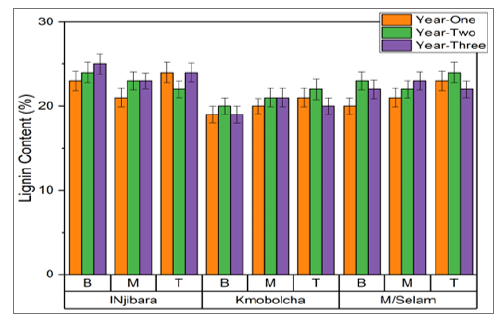
The bottom parts of Injibara bamboo is 7% higher lignin content than the middle, whereas 3 years old is 6% higher lignin content compared to 1year old. The top parts of Kombelcha bamboo is 8% higher lignin content the bottom, whereas 2years old is 5% higher lignin content compared to 3 years old.
The top parts of Mekaneselam bamboo is 6% higher lignin content than the bottom, whereas 2 years old is 7% higher lignin content compared to 1 years old.
The highest to lowest lignin contents are Injibara, Mekaneselam, and Kombolcha bamboo fibres respectively. Injibara bamboo fibres have 13%, and 4% higher lignin content than Kombolcha, and Mekaneselam bamboo fibres respectively, whereas Mekaneselam bamboo fibres is 9% higher lignin content than Kombolcha.
Y. alpina in 3 years old has 25.27% of lignin content which is higher lignin content than the current results of Injibara, Kombolcha, and Mekaneselam bamboo fibres [23].
Moso and Dendrocalamopsis oldhami bamboo have 20.35 and 20.9% of lignin content respectively, which are comparable with 1 and 2 years old, and lower than 3 years old of Kombolcha bamboo fibres, moreover, their lignin content are lower than Injibara and Mekaneselam bamboo fibres [24,26].
Bambosa vulgaris bamboo is 23.91% of lignin content which is higher lignin content than Kombolcha, Mekaneselam bamboo fibres, but lower lignin content than 3 years old of Injibara bamboo fibres [25].
Measuring extractive contents
Figure 9:The effect of age and height on the extractives content of bamboo fibres in Ethiopia.
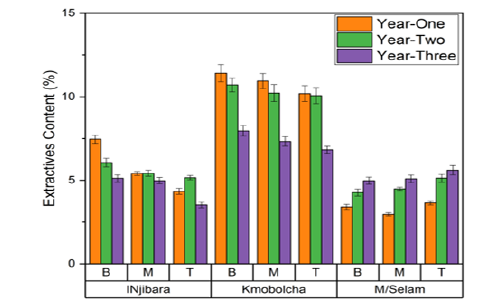
The influence of age and height on the extractives content is drawn in Figure 9. The mean extractives content of Injibara, Kombolcha, and Mekaneselam bamboo fibres have the highest extractives content value at the age of 1 (5.74%), 1 (10.85%), and 3 (5.23%), and lowest at the age of 3 (4.54%), 3 (7.37%), and 1(3.34%), whereas they are highest at the bottom (6.21%), bottom (10.03%), and top (4.8%), but lowest at the top (4.34%), top (9.03%), and middle (4.18%), respectively.
The bottom parts of Injibara bamboo is 30% higher extractives content compared to the top, whereas 1 year old is 21% higher extractives content than3 years old. The bottom parts of Kombelcha bamboo is 10% higher extractives content than the top, whereas 1 years old is 11% higher extractives content compared to 3 years old.
The top parts of Mekaneselam bamboo is 13% higher extractives content than the middle, whereas 3 years old is 36% higher extractives content compared to 1 years old.
The highest to lowest extractives contents are Kombolcha, Injibara, and Mekaneselam bamboo fibres respectively. Kombolcha bamboo fibres is 47%, and 52% higher extractives content compared to Injibara, and Mekaneselam bamboo fibres respectively, whereas Injibara bamboo fibres is 9% higher extractives content compared to Mekaneselam.
Dendrocalamopsis oldhami bamboo is 3.9% which is lower extractives content than Injibara, Kombolcha, and Mekaneselam bamboo fibres [26].
Bambosa vulgaris bamboo has 1.38% of extractives content which lower extractives content than Injibara, Kombolcha, and Mekaneselam bamboo fibres [25].
Measuring ash contents
The influence of age and height on the ash content is drawn in Figure 10. Injibara, Kombolcha, and Mekaneselam bamboo fibres have the highest ash content at the age of 1 (2.08%), 1 (2.53%), and 1 (2.25%), and lowest at the age of 2 (1.62%), 3 (1.77%), and 3 (1.51%), whereas they are the highest ash content at the bottom (2.31%), top (2.39%), and middle (1.93%), and the lowest ash content at the middle (1.56%), bottom (1.89%), and top (1.75%), respectively.
Figure 10:The effect of age and height on the ash content of bamboo fibres in Ethiopia.
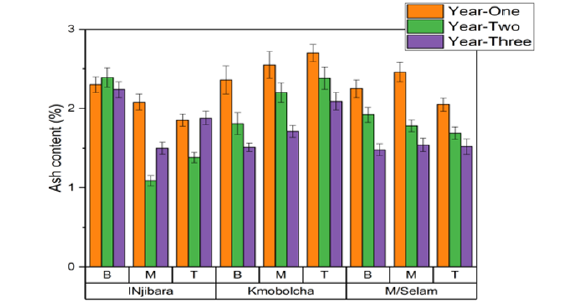
The bottom parts of Injibara bamboo is 33% higher ash content than the middle, whereas 1 years old is 22% higher ash content than 2 years old. The top parts of Kombelcha bamboo fibres is 21% higher ash content than the bottom, whereas 1 years old is 30% higher ash content than 3 years old.
The middle parts of Mekaneselam bamboo is 9% higher ash content than the top, whereas 1 years old is 33% higher ash content than 3 years old.
The highest to lowest ash contents are Kombolcha, Mekaneselam, and Injibara bamboo fibres respectively. Kombolcha bamboo fibres has 19%, and 12% higher ash content compared to Injibara, and Mekaneselam bamboo fibres respectively, whereas Mekaneslam bamboo fibres is 8% higher ash content than Injibara.
Bambosa vulgaris bamboo has 1.38% of ash content, which it is a lower ash content than Injibara, Kombolcha, and Mekaneselam bamboo fibres [25].
Y. alpina at the ages of 3 years-old has 3.77% of ash content,which it has a higher ash content than Injibara, Kombolcha, and Mekaneselam bamboo fibres [23].
G. atroviolacea bamboo has 3.29% of ash content, which it has a higher ash content than Injibara, Kombolcha, and Mekaneselam bamboo fibres. However, G. apus and G. levis have 2.45%, and 2.46% of ash content respectively, which they have a lower ash content than Injibara, Kombolcha, and Mekaneselam bamboo fibres [27].
Dendrocalamopsis oldhami bamboo has 1.5% of ash content, which it has lower ash content than Injibara, Kombolcha, and Mekaneselam bamboo fibres [26].
Figure the effect of age and height on the ash content of bamboo fibres in Ethiopia
The effect of age and height on the chemical composition of bamboo species in Ethiopia is presented in Table 4. Injibara and Kombolcha bamboo fibres have the highest value of cellulose content in 2 and 3 years old respectively, whereas Mekaneselam bamboo fibres measured comparable value of cellulose content in 1–3 years old. Percentage of cellulose contents of Mekaneselam has a higher value recorded compared to hemicelluloses contents. Injibara and Mekaneselam have a higher lignin contents compared to hemicelluloses contents, however, Kombolcha bamboo fibres has higher hemicelluloses contents compared to lignin contents in 1 and 2 years old.
Table 4:Summary results of the chemical composition of bamboo fibres in Ethiopia.
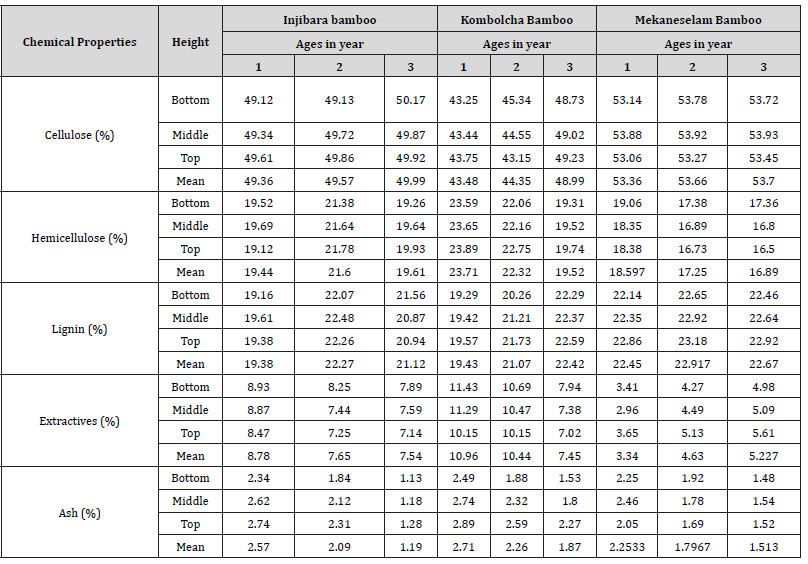
Statistical Results of Chemical Properties for Ethiopian Bamboo Species
Statistical analysis of cellulose content of Injibara bamboo fibres
As indicated in Table 5, the ages of the bamboo culm at F(2,44)= 175.97, P= 0.0000), and bamboo culm height at F(2,44)= 199.22, P= 0.0000) are statistically significant on the mean of Cellulose content.
Statistical analysis of hemicelluloses content of Injibara bamboo fibres
As indicated in Table 6, the ages of the bamboo culm at F(2,44)= 87.97, P= 0.0000), and bamboo culm height at F(2,44)= 22.14, P= 0.0000) are statistically significant on the mean of Hemicelluloses content.
Table 5:Cellulose content of bamboo culm for Injibara bamboo.

Table 6:Hemicelluloses content of bamboo culm for Injibara bamboo.

Statistical analysis of lignin content of Injibara bamboo fibres
As indicated in Table 7, the ages of the bamboo culm at F(2,44)= 9.78, P= 0.0003), and bamboo culm height at F(2,44)= 8.51, P= 0.0008) are statistically significant on the mean of lignin content.
Statistical analysis of Extractives content of Injibara bamboo fibres
As indicated in Table 8, the ages of the bamboo culm at F(2,44)= 28.93, P= 0.0000), and bamboo culm height at F(2,44)= 57.47, P= 0.0000) are statistically significant on the mean of Extractives content.
Table 7:Eignin content of bamboo culm for Injibara bamboo.

Table 8:Extractives content of bamboo culm for Injibara bamboo.

Statistical analysis of ash content of Injibara bamboo fibres
Table 9:Ash content of bamboo culm for Injibara bamboo.

As indicated in Table 9, the ages of the bamboo culm at F(2,44)= 13.69, P= 0.0000), and bamboo culm height at F(2,44)= 63.95, P= 0.0000) are statistically significant on the mean of ash content.
Statistical analysis of cellulose content of Kombolcha bamboo fibres
As indicated in Table 10, the ages of the bamboo culm at F(2,44)= 561.86, P= 0.0000) are statistically significant, however, bamboo culm height at F(2,44)= 2.51, P= 0.0936) are not statistically significant on the mean of Cellulose content.
Statistical analysis of hemicelluloses content of Kombolcha bamboo fibres
As indicated in Table 11, the ages of the bamboo culm at F(2,44)= 2938.85, P= 0.0000), and bamboo culm height at F(2,44)= 17.41, P= 0.0000) are statistically significant on the mean of hemicellulose content.
Table 10:Cellulose content of bamboo culm for Kombolcha bamboo.

Statistical analysis of lignin content of Kombolcha bamboo fibres
Table 11:Hemicellulose content of bamboo culm for Kombolcha bamboo.

As indicated in Table 12, the ages of the bamboo culm at F(2,44)= 471.5, P= 0.0000), and bamboo culm height at F(2,44)= 19.36, P= 0.0000) are statistically significant on the mean of lignin content.
Statistical analysis of extractives content of Kombolcha bamboo fibres
As indicated in Table 13, the ages of the bamboo culm at F(2,44)= 1107.25, P= 0.0000), and bamboo culm height at F(2,44)= 78.63, P= 0.0000) are statistically significant on the mean of extractives content.
Statistical analysis of lignin content of Kombolcha bamboo fibres
Table 12:Lignin content of bamboo culm for Kombolcha bamboo.

Statistical analysis of lignin content of Kombolcha bamboo fibres
Table 13:Extractives content of bamboo culm for Kombolcha bamboo.

Statistical analysis of ash content of Kombolcha bamboo fibres
Table 14:Ash content of bamboo culm for Kombolcha bamboo..

As indicated in Table 14, the ages of the bamboo culm at F(2,44)= 150.34, P= 0.0000), and bamboo culm height at F(2,44)= 62.17, P= 0.0000) are statistically significant on the mean of ash content.
Statistical analysis of cellulose content of Mekaneselam bamboo fibres
As indicated in Table 15, the ages of the bamboo culm at F(2,44)= 19.24, P= 0.0000), and bamboo culm height at F(2,44)= 52.47, P= 0.0000) are statistically significant on the mean of Cellulose content.
Statistical analysis of hemicelluloses content of Mekaneselam bamboo fibres
As indicated in Table 16, the ages of the bamboo culm at F(2,44)= 742.39, P= 0.0000), and bamboo culm height at F(2,44)= 126.89, P= 0.0000) are statistically significant on the mean of Hemicellulose content.
Table 15:Cellulose content of bamboo culm for Mekaneselam bamboo.

Table 16:Hemicelluloses content of bamboo culm for Mekaneselam bamboo.

Statistical analysis of lignin content of Mekaneselam bamboo fibres
As indicated in Table 17, the ages of the bamboo culm at F(2,44)= 19.13, P= 0.0000), and bamboo culm height at F(2,44)= 40.69, P= 0.0000) are statistically significant on the mean of Lignin content.
Table 17:Lignin content of bamboo culm for Mekaneselam bamboo.

Statistical analysis of extractives content of Mekaneselam bamboo fibres
As indicated in Table 18, the ages of the bamboo culm at F(2,44)= 340.49, P= 0.0000), and bamboo culm height at F(2,44)= 41.87, P= 0.0000) are statistically significant on the mean of extractives content.
Statistical analysis of ash content of Mekaneselam bamboo fibres
As indicated in Table 19, the ages of the bamboo culm at F(2,44)= 71.13, P= 0.0000) are statistically significant, however, bamboo culm height at F(2,44)= 3.78, P= 0.0313) are not statistically significant on the mean of ash content.
Table 18:Extractives content of bamboo culm for Mekaneselam bamboo.

Table 19:Ash content of bamboo culm for Mekaneselam bamboo.

Conclusion
The purpose of this study was to investigate how age and height affected the chemical composition of bamboo species in Ethiopia. As a result of this research, we observed small but significant increases in cellulose and lignin content from the base to the top of the culm in all three ages. The cellulose content of bamboo species in Ethiopia is increased when the age of the culm older. The hemicellulose content of Injibara, and Kombolcha bamboo fibres is a small but significant increase from the bottom to the top position, whereas Mekaneselam bamboo fiber is slightly decreased from the bottom to the top position. The hemicellulose content of Kombolcha and Mekaneselam bamboo fibres decreases when the age of the culm older, whereas Injibara bamboo fibres are the highest value of hemicelluloses content in 2 years old, but the lowest in 1 year old.
Injibara, and Mekaneselam bamboo fibres have the highest lignin content in 2 years old, but the lowest in 1 year old, whereas lignin content of Kombolcha bamboo fiber is increased when the age of the culm older.
The extractives content of Injibara and Kombolcha bamboo fibres decreased when the age of the culm older, and it move from the bottom to the top position, whereas the extractives content of Mekaneselam bamboo fiber increased from the bottom to the top position, and the age of the culm older.
The ash content of Injibara and Kombolcha bamboo fibres increased from the bottom to the top position, but it decreases when the age of the culm is older. Mekaneselam bamboo fiber decreases from bottom to top position in 2 years old, but it is the highest ash content in 2 years old.
The cellulose contents of Injibara, Kombolch, and Mekaneselam bamboo fibres are 49.12–50.17%, 43.25–49.02%, and 53.06– 53.93%, whereas the hemicelluloses are 19.12–21.78%, 19.31– 23.89%, and 16.51–19.06% in 1–3 years old, respectively. Furthermore, the lignin contents are 19.16–22.48%, 19.29– 22.59%, and 22.14–23.18% in 1–3 years old, respectively. This result demonstrated that bamboo species in Ethiopia can be a potential feedstock for lignocellulose ethanol and bamboo fibres composite production since it has a higher cellulose content. Based on the analysis results of the chemical composition of bamboo species in Ethiopia, it may be declared that it has good potential as raw materials for fiber composite production which substitute glass fibres.
Declaration of Competing Interest
The authors declare that they have no known competing financial interests or personal relationships that could have appeared to influence the work reported in this paper.
Acknowledgment
Researchers want to heartily thank Dr. Alemeyehu Wakjira, Dean, School of Mechanical, Chemical and Materials Engineering, and Mr. Mengistu Gelaw, program chair, Department of Mechanical Design and Manufacturing Engineering for their valuable inspiration, encouragement and providing necessary research facilities.
Conflict of Interest
No conflict of interest.
References
- M Kindu, Y Mulatu (2009) Status of bamboo resource development, utilization, and research in Ethiopia : A review. Ethiop J Nat Resour 1(1): 79-98.
- AA Kebede (2018) Opportunities and Challenges to Highland Bamboo-Based Traditional Handicraft Production, Marketing and Utilization in Awi Zone, Northwestern Ethiopia. Int J Hist Cult Stud 4(4): 57-67.
- A Inoue, S Sakamoto, H Suga, H Kitazato, K Sakuta (2013) Construction of one-way volume table for the three major useful bamboos in Japan. J For Res 18(4): 323-334.
- HN Hisham, S Othman, H Rokiah, MA Latif, S Ani, et al. (2006) CHARACTERIZATION OF BAMBOO SCORTECHINII AT DIFFERENT AGES GIGANTOCHLOA. 18(4): 236-242.
- JPJ Jr, MGM Macalinao, GN Sapin (2021) Physico-mechanical Properties of Two Philippine Bamboos Thermally Modified in a Steam Environment. 150: 171-182.
- W Tarmeze, W Ariffin, F Ahmad (1990) ANATOMICAL FEATURES AND MECHANICAL PROPERTIES OF THREE MALAYSIAN BAMBOOS. 2(3): 227-234.
- N Arun Jyoti, R Lal, AK Das (2015) Ethnopedology and soil quality of bamboo (Bambusa sp.) based agroforestry system. Sci Total Environ 521-522: 372-379.
- CORREAL D Juan Francisco, ARBELAEZ C Juliana (2010) INFLUENCE OF AGE AND HEIGHT POSITION ON COLOMBIAN GUADUA ANGUSTIFOLIA BAMBOO MECHANICAL PROPERTIES. 12(2): 105-113.
- SP Pubescens (2017) CHEMICAL CHANGES WITH MATURATION OF THE BAMBOO SPECIES PHY-LLOSTACHKS PUBESCENS. 19(1).
- T Tsuyama, Natsumi Shimada, Taichi Motoda, Yasuyuki Matsushita, Yoshio Kijidani, et al. (2017) Lignification in developing culms of bamboo Sinobambusa tootsik. J Wood Sci 63(6): 551-559.
- B Liu, Lina Tang, Qian Chen, Liming Zhu, Xianwu Zou, et al. (2022) Lignin Distribution on Cell Wall Micro-Morphological Regions of Fibre in Developmental Phyllostachys pubescens Culms. Polymers (Basel) 14(2).
- NP Marinho, EM Do Nascimento, S Nisgoski, I De Domenico Valarelli (2013) Some physical and mechanical properties of medium-density fiberboard made from giant bamboo. Mater Res 16(6): 1387-1392.
- Y Zhu, Jiawei Huang, Kaili Wang, Bo Wang, Shaolong Sun, et al. (2020) Characterization of lignin structures in phyllostachys edulis (Moso Bamboo) at different ages. Polymers (Basel) 12(1): 1-12.
- R Anokye, ES Bakar, J Ratnasingam, BK Awang (2016) Bamboo Properties and Suitability as a Replacement for Wood. PJSRR Pertanika J Sch Res Rev 2(1): 63-79.
- B Miller (2022) Structur of wood. pp. 22-23.
- R Wahab, MT Mustafa, MA Salam, M Sudin, HW Samsi, et al. (2013) Chemical Composition of Four Cultivated Tropical Bamboo in Genus Gigantochloa. J Agric Sci 5(8): 66-75.
- H Birara, RP Pandey, SK Mishra (2018) Trend and variability analysis of rainfall and temperature in the Tana basin region, Ethiopia. Journal of Water and Climate Change 9(3): 555-569.
- Staffan Rosell, Björn Holmer (2007) RAINFALL CHANGE AND ITS IMPLICATIONS FOR BELG HARVEST IN SOUTH WOLLO, ETHIOPIA. 89(4): 287-299.
- Abate Shiferaw (2012) Estimating Soil Loss Rates For Soil Conservation Planning in Borena Woreda Of South Wollo Highlands of Ethiopia: The Case from the Legemara Watershed. 2(2): 1-34.
- AO Ayeni, OA Adeeyo, OM Oresegun, TE Oladimeji (2015) Compositional analysis of lignocellulosic materials: Evaluation of an economically viable method suitable for woody and non-woody biomass. Am J Eng Res 44: 2320-847.
- C Sk, S Sp, S Naithani, P Srivastava, F Res (2016) Forest Research A Comprehensive Study on Proximate Chemical Composition of Melocanna baccifera ( Muli Bamboo ) and it’ s Suitability for Pulp and Paper Production. 5(2): 3-6.
- A Maisyarah, J Shiun, F Nasir, H Hashim (2018) Characteristics of Cellulose , Hemicellulose and Lignin of MD2 Pineapple Biomass. 7: 79-84.
- Mahelete Tsegaye, BS Chandravanshi, S Feleke, Mesfin Redi (2020) Chemical Composition of Yushania alpina (K. Schum.) WC Lin (1974)(Highland Bamboo) Grown in Ethiopia. World News Nat Sci 32: 1-9.
- X Li, C Sun, B Zhou, Y He (2015) Determination of Hemicellulose, Cellulose and Lignin in Moso Bamboo by Near Infrared Spectroscopy. Sci Rep, Vol. 5.
- S Nahar, M Hasan (2013) Effect of chemical composition, anatomy and cell wall structure on tensile properties of bamboo fiber. Eng J 17(1): 61-68.
- S Cao, X Ma, L Lin, F Huang, L Huang, et al. (2014) Morphological and Chemical Characterization of Green Bamboo (Dendrocalamopsis oldhami (Munro) Keng f.) for Dissolving Pulp Production. BioResources 9(3): 4528-4539.
- A Purbasari, TW Samadhi, Y Bindar (2016) Thermal and ash characterization of Indonesian bamboo and its potential for solid fuel and waste valorization. Int J Renew Energy Dev 5(2): 95-100.
-
Yalew Dessalegn*, Balkeshwar Singh and Aart W van Vuure. Effect of Culm Age and Height on the Chemical Properties tf The Culm in Different Bamboo Species. Glob J Eng Sci. 10(1): 2022. GJES.MS.ID.000726.
-
Age, Bamboo species, Cellulose, Hemicelluloses, Lignin, Culm height
-

This work is licensed under a Creative Commons Attribution-NonCommercial 4.0 International License.






